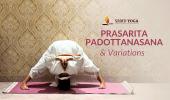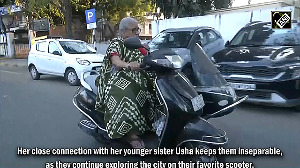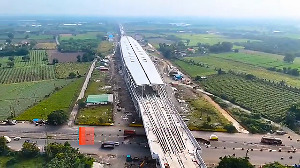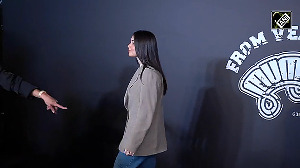Welcome to Day 6 of Rediff's week-long celebration of Yoga ahead of the International Day of Yoga.
Today, learn about Urdhva Dhanurasana, The Wheel Pose.

In celebration of the International Day Of Yoga Day, we arch into one of yoga’s most powerful backbends, Urdhva Dhanurasana, also known as Wheel Pose or Upward Bow Pose.
This expansive heart opener invites courage, energy and upliftment. It’s not just a physical posture -- it’s a conscious opening of the heart, a statement of trust and a full expression of vitality.
When approached with patience and alignment, Urdhva Dhanurasana offers deep transformation from spine to spirit.
What is Urdhva Dhanurasana (Upward Bow Pose)?
In Sanskrit, urdhva means upward, dhanu means bow and asana means pose. Together, Urdhva Dhanurasana refers to the upward-facing bow shape the body creates.
This deep backbend strengthens the arms and legs, energises the body and opens the entire front body -- including the chest, shoulders, hip flexors and heart.
It is a dynamic posture that bridges strength and surrender, demanding both activation and openness.
How to practise Urdhva Dhanurasana
Bridge Pose (Setu Bandhasana -- preparatory variation)
Lie on your back with your knees bent and feet flat on the mat.
Press into your feet and lift your hips while keeping your arms and shoulders grounded.
Interlace your fingers under your back for more chest expansion.
This is a gentle backbend to prepare for the Wheel Pose.
Crown-Of-The-Head Variation (Preparatory lift)
From the starting position, press into your hands and feet to gently lift your hips.
Bring the crown of your head lightly onto the mat, keeping your elbows pointing upward.
Ensure your neck is not bearing excessive weight.
Pause here to align your shoulders over your wrists and prepare for the full lift.
With control, either stay here to build strength or push into your hands to lift fully into Urdhva Dhanurasana.
The full pose (Standard Wheel Pose)
Lie on your back with your knees bent and feet hip-width apart, close to your sitting bones.
Place your palms beside your ears, fingers pointing toward your shoulders, elbows bent upward.
Inhale, press firmly into your hands and feet, lifting your hips and chest off the ground.
Straighten your arms as much as comfortable, bringing the crown of your head off the mat.
Keep your thighs parallel and firm, chest opening towards the wall behind you.
Breathe steadily and hold for a few seconds before slowly lowering down with control.
These variations help build confidence, flexibility and strength progressively.
Benefits of Urdhva Dhanurasana
- Strengthens the arms, legs, spine and glutes
- Expands the chest, shoulders, lungs and hip flexors
- Stimulates the thyroid and pituitary glands
- Boosts energy, vitality and emotional release
- Opens the heart and counteracts slouched posture
Contraindications
As this is an advanced pose, please keep in mind the following precautions:
Avoid if you have wrist, shoulder or lower back injuries
It is not recommended during pregnancy or menstruation
Those with high blood pressure or glaucoma should avoid or practise under guidance
Warm up thoroughly before attempting the full pose.
Opening beyond the physical
Urdhva Dhanurasana teaches us to meet discomfort with breath and resistance with openness.
As we rise into this graceful arc on the International Day Of Yoga, we’re reminded that Yoga is not about bending backward -- it’s about moving forward with a more open heart.
In the space above the chest, we don’t just find flexibility; we find light.
Please do see
- Day 1: Vriksasana, The Tree Pose
- Day 2: Virabhadrasana II, The Warrior II Pose
- Day 3: Utthita Trikonasana, The Extended Triangle Pose
- Day 4: Phalakasana, The Plank Pose
- Day 5: Urdhva Dhanurasana, The Wheel Pose
Atmarpit Dr Mansiji, MD, is the head of SRMD Yoga. She is a paediatrician, neonatologist and a certified yoga trainer by Yoga Alliance. She conducts yoga, breathwork and meditation workshops globally.
Disclaimer: All content and media herein is written and published online for informational purposes only. It is not a substitute for professional medical advice. It should not be relied on as your only source for advice.
Please always seek the guidance of your doctor or a qualified health professional with any questions you may have regarding your health or a medical condition. Do not ever disregard the advice of a medical professional or delay in seeking it because of something you have read herein.
If you believe you may have a medical or mental health emergency, please call your doctor, go to the nearest hospital or call emergency services or emergency helplines immediately. If you choose to rely on any information provided herein, you do so solely at your own risk.











